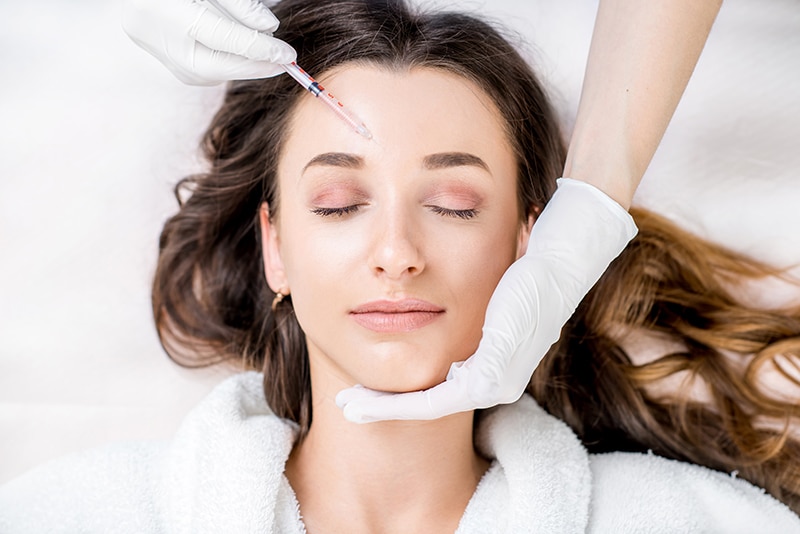5 Incredible Beauty Treatments We Got Completely By Accident
You'll find a bunch of Real Housewife-approved cosmetic treatments on this list.

Though beauty products and treatments are typically developed with specific intentions in mind, a handful of them came to us in a more creative and much more roundabout way. Take, for example, a serum that gives you Disney-worthy eyelashes that was originally meant to treat glaucoma, or a specific ingredient intended to treat one issue but proved itself highly effective in another area. With expert insight, we’re exploring a handful of these “by accident” origin stories.
No.1: Botox
You’d be hard pressed to stand in a crowded room without bumping into someone who’s indulged in the aesthetically enhancing benefits of Botox. (And in the world of the Real Housewives, you know this is a go-to treatment.) As you may know, it's a neurotoxin made from botulism (hence the name) that temporarily paralyzes the muscle it’s injected into. The result: a smoother, younger-looking surface.
Dr. Doft says, “The physician who discovered Botox was trying to treat patients with cross eyes. He noted that by injecting Botox, the facial muscles which lead to cross eyes weakened, thereby correcting the problem. However, the patients no longer had crow’s feet and, in fact, had an eye lift.”

The physician’s name was Dr. Alan Scott, an ophthalmologist practicing in the ‘80s in San Francisco. In a 2012 interview, he told CBS News that patients would even come in joking about wanting to “get the lines out.” The rest is billion-dollar history.
No.2: Coolsculpting
For those unfamiliar, Coolsculpting is the technique of gently freezing a localized area of the body in order to reduce the fat there. (Real Housewives Kelly Dodd and Dorinda Medley have both tried it — and raved about the results.) It was designed under the hypothesis that cool temperatures can selectively reduce the number of fat cells in your body without damaging nerves, muscle, or skin cells, and the before and after images are pretty damn compelling.
“Doctors realized that cheek fat decreases after sucking on popsicles, a phenomenon called popsicle panniculitis. Furthermore, a woman who used to ride her horse naked on cold days noted that it reduced the fat on her inner thighs,” notes Dr. Melissa Doft, a NYC-based plastic surgeon. “Both these stories sparked scientists to conceive the idea that fat can be reduced by the cold — and it works. Applying cold temperatures to fatty tissue will cause the fat cell to freeze and then undergo apoptosis or cell death. The dead cell is then absorbed by your body.”
No.3: Latisse
You know Latisse as one of the industry’s premiere lash growth serums, but it wasn’t always used for that purpose.
“The drug Lumigan was designed to treat Glaucoma, which is a disease of the eyes where there is increased intra-ocular pressure,” explains Dr. Laurence T. Glickman, a board-certified plastic surgeon at Long Island Plastic Surgery Group. “This drug was noted to have several side effects, one which caused an increase in eyelash growth.”
When patients started sporting darker, extra-long lashes weeks into their treatment, a medical opportunity was seized and Latisse was born.
No.4: Microcurrent Technology
“Microcurrents were first FDA-approved for the use in Bell’s palsy, a neurological disease which causes facial drooping due to inactive facial muscles. They were used to help strengthen these muscles and to reduce facial sagging,” says Dr. Doft. “Once it was noted that facial sagging could be improved, it was then introduced to the cosmetics arena where it is a popular treatment for aging skin.”
Today, you can buy microcurrent tools for at-home use, or you can hit a spa or dermatologist’s office for an indulgent, highly effective facial.
No.5: Retinol
Today we know retinol as one of (if not the) best topical anti-aging ingredient your money can buy. Nearly every dermatologist you meet not only touts its benefits, but they religiously use it themselves. This is because, study after study, retinol proves itself. Perhaps the most compelling study was a side-by-side comparison where participants took a “before” image and then, five years after consistently using retinoic acid, an “after” image. Blinded professionals consistently ranked the “after” picture as looking younger than the before.
Originally, though — back in the ‘40s — retinol was intended to treat acne. “As acne patients aged, doctors noticed the benefits of daily retinol use,” says Dr. Doft. This includes improved barrier function, smoother skin, and fewer laugh lines. “It’s now it is the number one anti-aging ingredient.”
Who knows what sort of roundabout way we’ll luck into the next latest and greatest beauty treatment. We just hope it’s something that can miraculously get rid of those pesky sun spots or dark circles.




